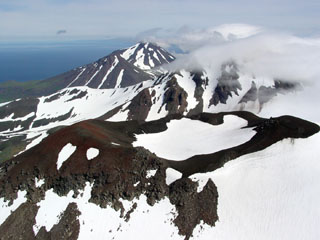Report on Atka Volcanic Complex (United States) — 27 March-2 April 2024
Smithsonian Institution / US Geological Survey
Weekly Volcanic Activity Report, 27 March-2 April 2024
Managing Editor: Sally Sennert.
Please cite this report as:
Global Volcanism Program, 2024. Report on Atka Volcanic Complex (United States) (Sennert, S, ed.). Weekly Volcanic Activity Report, 27 March-2 April 2024. Smithsonian Institution and US Geological Survey.
Atka Volcanic Complex
United States
52.331°N, 174.139°W; summit elev. 1518 m
All times are local (unless otherwise noted)
A small, brief, explosion at summit crater of Korovin, one of the volcanoes at the Atka volcanic complex, was detected at 1936 on 27 March, prompting AVO to raise the Volcano Alert Level to Advisory (the second level on a four-level scale) and the Aviation Color Code to Yellow (the second color on a four-color scale). The event was recorded in local infrasound and seismic data and was followed by a few minutes of elevated seismic tremor. Low-frequency earthquakes and periods of seismic tremor were detected during 30 March-1 April. Satellite and web-camera views were mostly obscured by clouds through 1 April, though no significant ash deposits were visible in a few clear images.
Geological Summary. The Atka Volcanic Complex consists of a central shield and Pleistocene caldera and four notable volcanic cones. A major explosive dacitic eruption accompanied formation of the caldera about 500,000 to 300,000 years ago; approximately half of the caldera rime remains, open towards the NW. The Sarichef cone, ~5 km ESE of the caldera rim, retains a symmetrical profile, unlike most other heavily eroded features outside the caldera to the S and W. The Kliuchef stratovolcano grew within the caldera and exhibits five eruptive vents striking NE, including two at the summit, that have been active in the Holocene. A 700-m-diameter crater 1 km NE of the summit may have been the source vent for a large 1812 CE eruption. Hot springs and fumaroles are located on the flanks of Kliuchef and in a glacial valley to the SW. The most frequently active volcano of the complex is Korovin, at the NE tip of Atka Island about 5 km N of Kliuchef. An 800-m-diameter crater on the SE side of the summit contains a deep circular pit that sometimes contains a crater lake thought to be the source of phreatic ash explosions. The smaller Konia cone, slightly offset to the E, lies between Kliuchef and Korovin. Most of the lava flows in the complex are basaltic, though some dacitic flows are also present.
Source: US Geological Survey Alaska Volcano Observatory (AVO)

